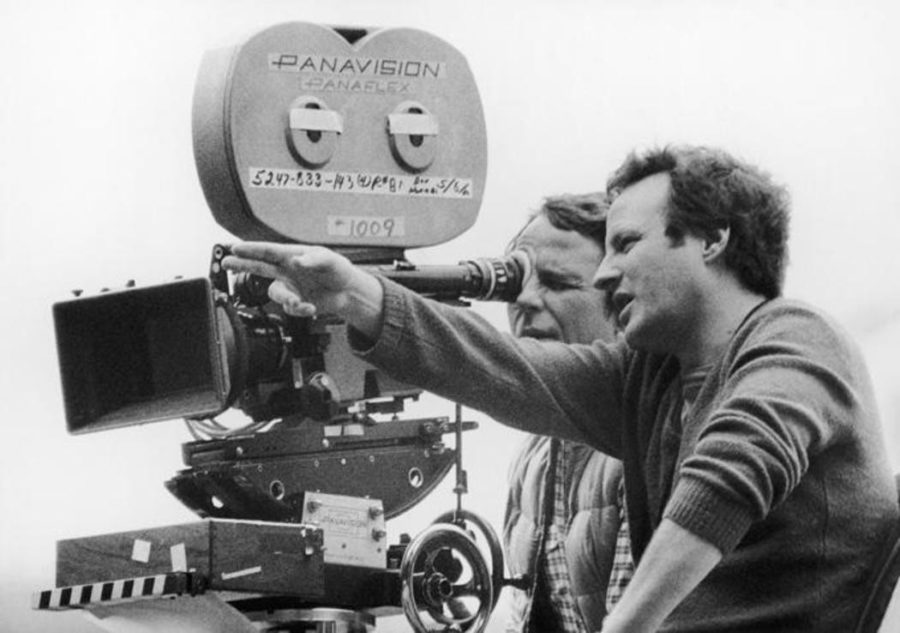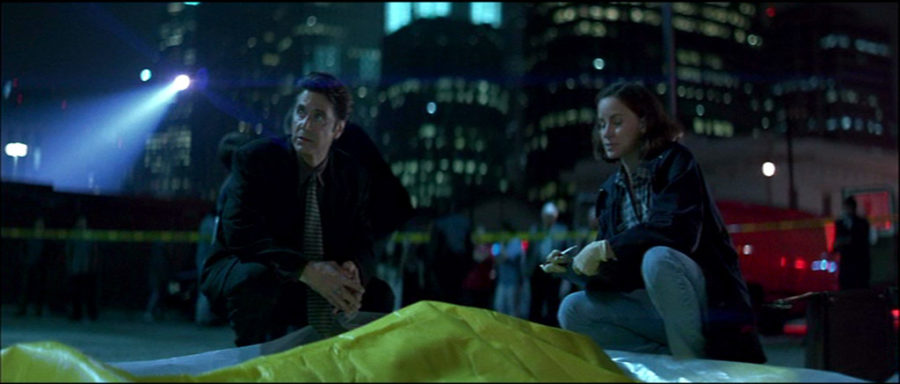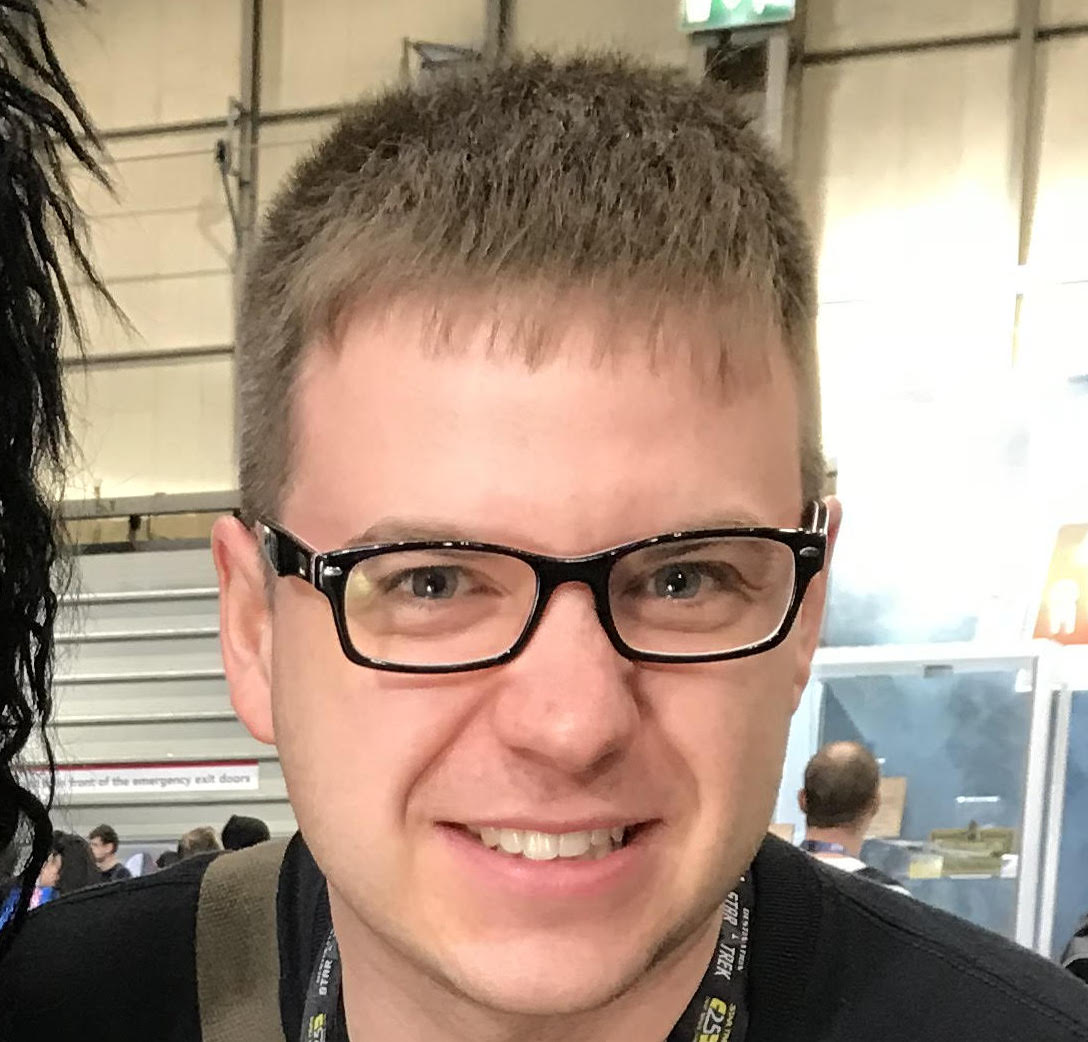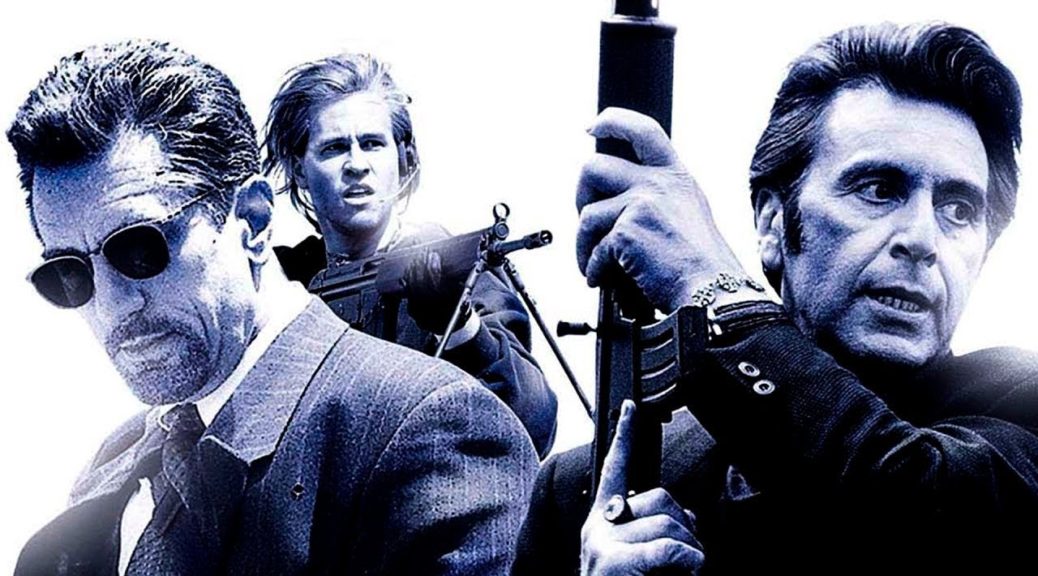It’s rare that films come along that are recognized as an instant classic, but 25 years ago the Michael Mann written and directed crime epic Heat did just that. Heat was not just any crime thriller; it was an intricate story that wove interconnected plots together like a fine suit with a realism that is rare in crime cinema. Not only that, it was one of the most meticulous and detailed films not only in the crime genre itself but in all of cinema history.
It is not widely known but Heat was actually based on a true story that happened in Chicago in the early 1960s. Neil McCauley was a real career criminal who had been in and out of prison throughout his entire adult life. The pursuit of McCauley was led by Chicago Detective Chuck Adamson, who would later serve as the inspiration for the character of Vincent Hanna. Adamson and McCauley did sit down and have coffee like in the movie and on 25th March 1964 McCauley was chased down during the execution of a robbery and gunned down by Adamson. When Michael Mann was introduced to Adamson by a mutual friend, a man by the name of Nate Grossman, the McCauley story captured Mann’s imagination. He put a lot of the real events into the story that would eventually become Heat.
Through his relationship with Adamson, Michael Mann was introduced to several people on both sides of the law. Through his interactions with these people Mann gained an understanding of both the mentality of being a Detective, or as he saw them hunters, and the mentality that came with being a career criminal. It was an authenticity that he wanted to put into his writing, in his first theatrical film, Thief, Mann cast several real-life police officers, including Dennis Farina who would later go on to become a well-known actor. On top of the police officers he cast in Thief he also cast real life jewel thief, John Santucci, as a police officer. Santucci also served as Mann’s technical advisor on Thief and his later TV series Crime Story, which also starred Dennis Farina.

Whilst Mann worked on various TV and film projects throughout the 1970s and 1980s, he was always working on his screenplay for Heat and after failing to sell the project as a theatrical motion picture he decided to extract 40% of the material from his theatrical screenplay and use it as a TV pilot. He did this purely to work with the material which he had been working on for over 10 years at this point. The series was not picked up but the pilot was later released as a TV movie under the title L.A. Takedown. The TV movie is an interesting watch because there are so many elements from Heat that are there but done on a TV budget and a TV schedule. There are differences, for example the meeting between Hanna and McCauley, who in the TV movie was called Patrick McLaren, is a lot closer to the real events than the film. Hanna and McLaren bump into each other in a parking lot and instead of getting into a shootout they go for a coffee, that is how the meeting between Adamson and the real McCauley actually occurred.
After L.A. Takedown Michael Mann went on to direct The Last of The Mohicans before returning to the material. When making Heat as a theatrical feature he was able to finally work with everything he had and not have to cut it down to be a TV movie. A producer friend of his, Art Linson, read the script and told him that he was nuts and that it should be his next film. Linson felt that the project would be really good for Robert De Niro and Michael Mann approached Al Pacino. Luckily De Niro felt that McCauley was the right character for him and Pacino wanted to play Hanna, all of a sudden Heat became an event in cinematic history, finally Robert De Niro and Al Pacino would be on screen together.
Al Pacino wanted to differentiate the Hanna character from McCauley by being more animated and hyperactive than De Niro’s calm and cool portrayal of McCauley. To explain this Pacino came up with the idea that Hanna chipped cocaine, this behavior does not appear on screen, but that gave Pacino the freedom to go as big as possible with the character. Hanna is an addict, he’s addicted to the hunt, as his wife Justine, portrayed by Diane Venora, says he doesn’t live with people he lives among the remains of the dead, he searches for the scent of his prey and hunts them down, that is the only thing that Hanna is committed to.

Pacino’s ability to control the scene and command the screen really shines in Heat, the scenes where he reads crime scenes or senses something are incredible to experience. In his performance you can see the character really come alive when he is on the hunt, when he is with Justine you can sense that he isn’t present. The subtleties in Pacino’s performance are in his body language, whilst his character is animated and over the top there are also subtle elements which is what makes his performance so nuanced. However, the freedom Pacino had to explode at the drop of the hat really gave the character a power and his performance informed the performances of his fellow cast mates. In particular the reaction from Hank Azaria when Pacino yelled “But she’s got a great ass!” at him was a genuine reaction because he was not expecting Pacino to explode at him like that.
Where Pacino was overly animated in his portrayal, De Niro captured the essence of the quiet professional. De Niro signed onto the project first and his main reason was because he felt that the film looked like it would be a lot of fun to make. The way he approached McCauley was as a man who felt his every action was justified, even the most heinous actions he takes in the film. The interesting aspect of the character was that even though he was the “bad guy” in the story he also had a quality about him that made you want to root for him. We learn more about his human side from his courtship of Edie who he initially is cold and almost aggressive towards because of his paranoia about being surveyed. However, this relationship blossoms into one of the better romantic relationships in the film which adds more to McCauley’s humanization in the film. He isn’t just the straight up bad guy that a lot of films portray and in the end the audience wants McCauley to get away with Edie and have a happy ending.

Amy Brennerman who played the role of Edie didn’t like the script as she felt that the characters were despicable and there was no morality. This was why Michael Mann told her that she had to do it because in the whole film Edie is the one person who is saying to the characters “Who are you people?” She is the one character who is truly disconnected from that world throughout the majority of the film. The real tragedy of the picture is when McCauley finally reveals who he is to her and she accepts him because she loves him, he still is able to walk away from her when he spots Hanna approaching. The notion of not having attachments that you are not willing to walk away from in ten seconds is a true discipline in McCauley’s life. And even though he does truly fall in love with Edie he still walks away from her, even though you can see the pain and regret in his eyes, but he has to.
The amount of research that went into the film is staggering, there is the years of research that came from the initial story and little stories that Michael Mann had heard from various cops and criminals throughout the years he had been writing the script but also when they hit pre-production Mann rode around with LAPD Commander Tom Elfmont for six months. They answered any calls on the radio, homicides and even armed robberies in progress. Elfmont spoke about Mann becoming his partner and that he had a spare gun that he would occasionally give Mann to use if needs be. These six months taught Mann about Los Angeles and he found several locations for the film in just riding around with Elfmont. One of the key things that Mann learnt about the police in his interactions with Elfmont was that the police themselves are not used to being assaulted with overwhelming force. When staging the main shootout of the film he took that into consideration on the execution of the scene which is why McCauley’s crew are so violent in their escape, it is to get out fast whilst the LAPD are still mobilizing and trying to handle the situation.
In order to get the actors in McCauley’s crew used to being criminals he staged several interrogations with the actors to put them in the mindset that their characters would have been in. The actors also visited prisons where people like their characters ended up. Tom Sizemore spoke in an interview about how he spoke with a man who was in prison who had a lot of money, enough that he wouldn’t have needed to rob banks but he still did it anyway. When he asked him why he kept robbing banks he replied, “It’s my job, it’s what I know to do, I rob banks.” These interactions gave the actors a real window into the lives of the characters they were portraying because all of them would have had similar outlooks in life to these people. Mann also had everyone in McCauley’s crew read Eddie Bunker’s book, No Beast So Fierce, as he felt that it was one of the most honest pieces of writing about being a criminal he had read. He also brought Bunker on as a technical consultant.
Ashley Judd spoke with wives and girlfriends of bank robbers to help her understand her character, Charlene, more. The way that she both loved and hated her husband at the same time. Diane Verona would listen to Detectives speaking with each other and she quickly realized that their wives and girlfriends were not that important to them when it came to their life as a police officer. To capture as much realism as he could Mann had as many of the real people for extras in roles as police officers or medical staff. The background characters in the aftermath of the first robbery were all either real detectives or real forensic investigators playing themselves which added to the realism of the sequence.
In preparation for the film De Niro, Kilmer and Sizemore all cased a real bank as if they were going to rob it for real. Sizemore even went through the process of filling out a loan application to get a look around more of the bank. Kilmer spoke about how short of actually committing murder everything their characters did in the film they did for real in preparation for the shoot. Which brings us onto the firearms training, the actors trained for months firing live ammo, something that at the time was relatively unheard of in preparation for making a movie.
For the weapons training of the film Mann turned it over to Mick Gould and Andy McNab, two former SAS Operatives who had seen action all over including Northern Ireland during The Troubles. Gould and McNab drew up a training curriculum for both the cops and the criminals to train to. The cop actors would train with real Police Officers on the range whilst the criminals would work closely with Gould and McNab. Not only would they train with live ammo they would also do a dress rehearsal of the big shootout on a scale model set on the LA County Sheriffs firing range firing live rounds. The way they moved whilst shooting live ammo on a range was how they moved from position to position in the film itself. Doing it with live ammo and learning how to do these things gave the actors more of a credibility and more of a believability in their performances because they had a level of knowledge in their abilities that they could do everything they were doing for real. It gave their performances a level of sincerity and confidence that films seldom have because the actors themselves are faking a lot of it. For Heat the actors did not have to fake much because they knew how to do the same things that their characters could. Kilmer spoke of the training as being the best part about playing Batman in Batman Forever as he would play Batman through the week and on weekends prepare for Heat.

Because of the location of the major shootout and the enormity of the sequence they were only permitted to shoot on weekends. For each take in the shootout they burnt through 800 to 1000 rounds of blank ammunition, the sound of the shootout was deafening and the rapport of the gunshots would echo off the buildings in the area creating what was described as a horrific sound. In order to capture the realism of what a 5.56 round does they actually took several cars to a shooting range and shot them up with real 5.56 rounds and then filled the holes in with Bondo so when the squibs blew out the Bondo what was left was real bullet holes created by real 5.56 rounds. In an early stage of the editing process they put together a sound mix for the shootout and when viewing it Michael Mann reportedly said, “That’s not the gunshots.” The sound mixers all looked at each other and realized what he was referring to. The production sounds from the shooting were much more visceral and powerful than anything they could put together because of the sound that the shots had echoing off the glass buildings. Add to the closeness of the camera work and it created a feeling of being assaulted and being caught in the middle of a huge shootout.
Despite the shootout getting a lot of notice, the best scene in my opinion is the pivotal restaurant scene. This conversation between Hanna and McCauley actually happened in real life, and whilst the dialogue in the film was probably not even close to what was really said, Chuck Adamson and the real Neil McCauley did actually go for a coffee. It happened whilst Adamson was picking up some dry cleaning, he spotted McCauley who spotted him and instead of pulling their guns Adamson suggested they go for a coffee. Even though these men were on completely the opposite side of the law from each other and were going to one day be staring down the end of a gun at each other they had what could be described as a brief friendship. Adamson spoke of McCauley as a bright person who he could have just as easily gone for a beer or to a ballgame with, despite this he did not give him an inch and when it came down to it, he didn’t hesitate to kill McCauley.
The coffee shop scene in the movie was written in two ways, the first was that it was just a regular conversation between two people who have a mutual admiration for each other, the other is that each person is reading the other trying to gauge their own psyches. Each line of dialogue has this double meaning behind it, it’s just normal chat but it also offers a window into who they are as a person. The scene was shot with three cameras simultaneously, an over the shoulder on both Pacino and De Niro and a two shot of them both. Due to the positioning of the cameras if any one of them had moved a centimeter to the side they would have caught the other camera. In order to make sure that Pacino and De Niro were not fully focused and were a little tired to get a more natural performance Mann intentionally didn’t start shooting the scene until 1am. There were no rehearsals of the scene because they were sitting throughout so they didn’t have to do any blocking of the scene but also Mann doesn’t like rehearsing because he feels that a scene will only be perfect once and its important to capture that on camera. If it’s perfect in rehearsal then you’ve lost your perfect scene.

Because the two shot was never used in the scene there was a rumor that neither Al Pacino or Robert De Niro were every actually in the scene together, this is of course a load of rubbish. They shot the scene multiple times and a lot of the footage that is actually in the film is from Take 11. The scene is great not only because of the fact that Pacino and De Niro are acting alongside each other for the first time ever but also because of how it just feels like a normal conversation but there is more going on than that. Each actor reacts to slight movements from the other, an eye twitch here, a hand moving there. You can feel the tension but also the sense of admiration the characters have for each other in the scene, it’s a wonderful tennis match of dialogue. I could watch it over and over again and in truth I have. The scene is like an acting masterclass, actor Tom Hiddleston actually slightly derailed an interview with Robert De Niro on The Graham Norton Show gushing about his love for the scene, and if I was him, I would have done the same thing. In the same interview De Niro spoke about how the scene was his favorite written scene in the film.
Heat’s plot consisted of a series of interconnecting events which formed the complete story; there is nothing in the film that isn’t serving the story line in some way. What seems like an inconsequential moment early in the film is tied into the main story line. The story line that involves ex-con Donald Breedan trying to make ends meet after getting out of prison was included not only as a way to get a replacement getaway driver for the main heist but also as a commentary on just how difficult it is for ex-cons to go straight and how the way they are treated after they get out makes it so easy for them to fall back into crime. It’s an interesting insight into this part of crime that is rarely explored in Hollywood cinema. The way his boss treats him, taking a portion of his wage for himself and threatening him with violating him back to the joint if he complains. It’s no wonder why so many ex-cons return to criminal life when they are treated like that.
Michael Mann’s attention to detail in the film is staggering. There are decisions made about everything. I was at a talk given by Andy McNab several years ago and I asked him what it was like working with Michael Mann and he commented about the level of detail Mann put into the tiniest of things. He spoke about how he spent three hours deciding on a watch for Jon Voight’s character, Nate Grossman, to be wearing in a shot that appears on screen for at most two seconds. When McNab asked him why it took him so long Mann explained that he didn’t want anything in his films that would pull the audience out, if the watch that Grossman was wearing did not fit his character then on a subconscious level the audience would be pulled out of the film for a few seconds. There are also small details in the film that are things that normally you don’t see in films such as when they are about the breach Hugh Benny’s apartment. Casals unloads his shotgun, which as standard would have been loaded with buckshot, and loads in some slugs that will be used to blow the locks off the door.
Heat is a film that has been a source of inspiration to many contemporary film makers including Christopher Nolan who took a heavy amount of inspiration for The Dark Knight from Heat. It is a modern classic and one of the greatest, if not the greatest, crime thrillers of all time. The true events that inspired the film may have been a Chicago Tale, but Heat is definitely a tale of Los Angeles. It’s a film with no real villains and no real heroes, it’s a film that only contains people and there is no clear black and white to them, everything is grey which is what real life is like. Michael Mann spoke about how he was never inspired to write Heat by other films or stories, Heat was inspired by real police officers and real criminals who he had spoken to throughout his life. There is no sense of fortuitousness in the film, nothing happens by chance, every action in the film serves to push the characters towards their own endings which again is how life works. Nothing happens by chance, there is a reason for everything because we as people make choices that put us where we end up. Heat is ultimately a film about the choices people make and how their actions unfold. It’s a fascinating and realistic portrayal of life on both sides of the law and you would be hard pressed to find another film that is quite like it in the same way.

Matt is a huge film and TV buff who studied film and moving image production at university. In his spare time he enjoys reading comics and books, the occasional gaming session and writing novels.


Brilliant article about a film which blew me away when i first saw it 25 years ago !! One character i am always puzzled by is Waingro, he is extremely dark and violent and frightening to think people like that exist !!!! Do you know if during your research you found out if he was based on a real character ??
Knowing how Michael Mann approaches his films and Heat in particular I would guess that Waingro was based on at the very least one real person. Most likely several. Pretty much all the characters were based on real people. I just had a quick look online and there was a real criminal called Waingro who turned states evidence against some Chicago mobsters. He was found nailed to a shed in Mexico several years later. How much of the character in Heat was based on the real one I don’t know though.
[…] GuestMatt Dykeshttp://athpod.com/2020/04/23/a-modern-american-classic-the-25th-anniversary-of-heat/ […]
I still think it’s a really good movie. I wanted to know what you think of this article.
https://jamesjguild.com/blog/2017/3/5/movie-review-michael-manns-heat-is-a-waste-of-time-masquerading-as-a-masterpiece
I tried to read all of that but I couldn’t get through it. They’re talking a load of rubbish. And when you have the word turd in your article’s title you’re already losing credibility in my opinion. People are entitled to not enjoy a movie, but you can’t deny that the film is an exceptionally well made film that has zero plot holes that I can see.
Yeah, I don’t know what version of Heat the reviewer actually seen because I didn’t find the movie to have any major plot holes or questionable character decisions at all . It’s like we either saw a different film or they didn’t actually pay attention to the movie. I agree that Heat is a timeless classic, for action-crime/heist films, I think it’s easily one of the best.